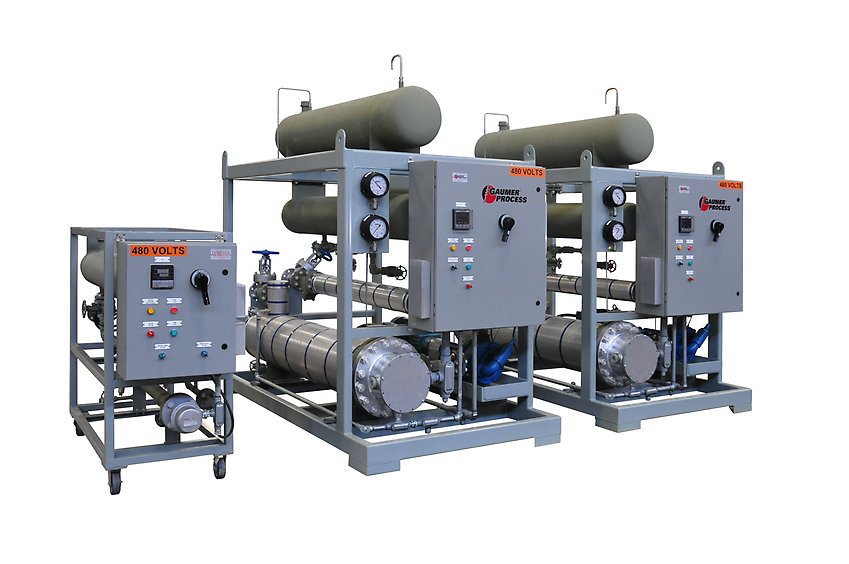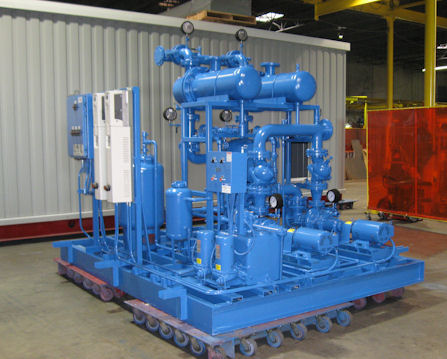Actionable Tips for Using DVS Heat Transfer Systems in Data Centers
A Comprehensive Guide to Picking the Right Heat Transfer Solutions for Your Requirements
Picking the proper Heat transfer system is crucial for functional performance. Different systems cater to different needs, affected by elements such as temperature array and fluid kind. Recognizing the concepts behind Heat transfer, such as radiation, transmission, and convection, is crucial. Additionally, reviewing power sources and maintenance practices can influence long-lasting efficiency. A closer exam of these considerations reveals how to customize a system to particular requirements. What should one prioritize in this facility decision-making process?
Comprehending Heat Transfer: Key Ideas and Concepts
Heat transfer may appear like a simple concept, it incorporates a variety of concepts that are essential for efficient system layout - DVS Heat Transfer Systems. Understanding these principles is necessary for engineers and designers that aim to optimize thermal efficiency in various applications. Transmission, as an example, includes the transfer of Heat through strong materials, while convection refers to the motion of Heat within fluids. Radiation, another key principle, describes how Heat can be transferred through electromagnetic waves. Each of these mechanisms plays an important function in determining how energy relocates within a system. By extensively realizing these ideas, specialists can make educated decisions, ensuring that Heat transfer systems run effectively and satisfy the certain needs of their applications
Kinds of Heat Transfer Solutions: An Introduction
Comprehending the principles of Heat transfer prepares for exploring the numerous kinds of Heat transfer systems offered. Heat transfer systems can be classified largely right into 3 types: conduction, radiation, and convection. Conduction entails Heat transfer via strong materials, relying upon direct get in touch with between particles. Convection, on the various other hand, happens in fluids (fluids and gases) where the motion of the fluid itself assists in Heat transfer. Radiation entails the transfer of Heat via electro-magnetic waves and does not call for a tool, permitting it to happen in a vacuum. Each sort of system has unique attributes and applications, making it vital for people and organizations to very carefully analyze their certain needs when choosing the most appropriate Heat transfer option.
Applications of Heat Transfer Solutions in Various Industries
Heat transfer systems play a vital role across various sectors, affecting efficiency and product high quality. In industrial manufacturing procedures, they facilitate precise temperature level control, while in food and beverage processing, they guarantee safety and security and conservation. Additionally, a/c and climate control systems count heavily on reliable Heat transfer to keep comfortable atmospheres.
Industrial Production Processes

Various industrial production procedures rely heavily on effective Heat transfer systems to take full advantage of performance and boost product quality. In industries such as metalworking, Heat exchangers play an important function in preserving ideal temperatures during welding, casting, and creating. These systems assure uniform Heat distribution, which is important for accomplishing desired material buildings. In the chemical manufacturing industry, Heat transfer systems promote accurate temperature control during reactions, affecting yield and safety and security. In addition, in fabric manufacturing, reliable Heat management is very important for dyeing and finishing procedures, influencing color consistency and textile top quality. By selecting appropriate Heat transfer innovations, producers can enhance energy performance and minimize operational expenses, ultimately bring about a much more sustainable and competitive manufacturing environment.
Food and Drink Handling
Efficient Heat transfer systems are equally crucial in the food and drink processing sector, where keeping ideal temperature levels is essential for food security and quality. These systems play a crucial role in processes such as pasteurization, cooking, and sanitation, making sure that products are safe for consumption and maintain their nutritional value. Heat exchangers, for example, efficiently transfer Heat in between liquids, enhancing energy usage while minimizing temperature level changes. In addition, refrigeration systems are fundamental for expanding and preserving disposable products service life. The option of Heat transfer technology directly influences functional efficiency and product stability, making it necessary for food and beverage makers to choose the suitable systems customized to their details handling needs. This cautious choice eventually adds to consumer contentment and food safety.

A/c and Climate Control
While numerous sectors rely upon Heat transfer systems for efficiency, HEATING AND COOLING (Heating, Ventilation, and Air Conditioning) plays a crucial duty in keeping indoor environment control across various setups. These systems utilize Heat transfer concepts to regulate moisture, air, and temperature level high quality, guaranteeing convenience and safety and security in household, industrial, and commercial settings. Correctly made a/c systems enhance energy effectiveness, minimize operational costs, and reduce environmental effect. In commercial structures, as an example, reliable environment control adds to staff member productivity and client complete satisfaction. In industrial applications, cooling and heating systems aid preserve ideal conditions for tools procedure and product conservation. Picking the right Heat transfer system is essential for conference specific climate control requirements and achieving overall system efficiency.
Reviewing Power Sources for Heat Transfer Solutions
In evaluating power sources for Heat transfer systems, a comparison of renewable resource choices and fossil fuel considerations is essential. Renewable sources, such as solar and wind, offer sustainable alternatives that can minimize environmental impact. Conversely, fossil fuels remain widespread as a result of their well established infrastructure and power density, triggering a careful evaluation of both alternatives.
Renewable Power Options

Nonrenewable Fuel Source Considerations
Evaluating nonrenewable fuel source factors to consider is essential for the efficiency and sustainability of Heat transfer systems. Fossil gas, such as gas, oil, and coal, are conventional power resources that provide substantial Heat result, making them popular choices for residential and commercial applications. Their ecological influence, including greenhouse gas you can try this out exhausts and resource exhaustion, raises worries. When selecting a warm transfer system, it is important to assess the schedule, cost, and regulative variables connected with these fuels. In addition, the performance of nonrenewable fuel source systems must be considered, as higher effectiveness can reduce some ecological drawbacks. Inevitably, a well balanced technique weighing efficiency and sustainability can lead decision-makers towards one of the most suitable Heat transfer option for their details needs.
Variables to Consider When Choosing a Warm Transfer System
Choosing an ideal Heat transfer system calls for mindful consideration of various factors that can considerably influence effectiveness and efficiency. One essential element is the operating temperature variety, which determines the materials and layout ideal for the application. Additionally, the kind of fluid utilized in the system-- whether gas or liquid-- impacts Heat transfer performance and compatibility. The system's dimension and ability have to straighten with the specific needs of the operation to avoid ineffectiveness. Energy source schedule is additionally vital, influencing operating expense and sustainability. The setup setting, including area restrictions and access for maintenance, plays a substantial duty in system choice. Governing compliance and safety and security requirements need to be considered to assure the system satisfies all lawful demands.
Upkeep and Efficiency Optimization for Heat Transfer Solutions
Maintaining Heat transfer systems is important for ensuring optimal efficiency and long life. Regular upkeep tasks, such as cleaning up Heat exchangers and evaluating insulation, assistance avoid performance losses because of fouling and thermal linking. Additionally, monitoring system specifications, including pressure and temperature level, permits very early discovery of anomalies, minimizing downtime and expensive fixings. Implementing a preventive maintenance routine can optimize performance and expand the lifespan of elements. In addition, updating to advanced control systems can boost operational effectiveness by getting used to varying loads and problems. By focusing on upkeep and efficiency optimization, operators can accomplish lowered power consumption, lower operational costs, and enhanced general system reliability, eventually leading to far better resource use and an extra lasting procedure.
Future Fads in Heat Transfer Technologies
As industries progressively focus on sustainability and energy efficiency, future trends in Heat transfer technologies are set to go through considerable improvements. Technologies such as innovative materials, consisting of carbon nanotubes and nanofluids, guarantee improved thermal conductivity and effectiveness. In addition, the assimilation of renewable resource sources into Heat transfer systems is acquiring momentum, advertising green options. Smart technologies, including IoT sensing units, are expected to change monitoring and control, enabling real-time information evaluation for enhanced performance. Furthermore, the growth of portable and modular systems will facilitate less complicated setup and upkeep, satisfying diverse applications. These improvements indicate a change towards even more lasting, effective, and versatile Heat transfer remedies, lining up with international energy objectives and environmental criteria.
Frequently Asked Inquiries
What Are the Ecological Influences of Heat Transfer Systems?
The ecological effects of Heat transfer systems can include greenhouse gas exhausts, energy usage, and possible thermal air pollution. Additionally, incorrect disposal of products and ineffectiveness can contribute to resource exhaustion and community disturbance.
Just how Do I Calculate the Cost-Effectiveness of a Heat Transfer System?
To determine the cost-effectiveness of a heat transfer system, one need to assess initial expenses, functional expenditures, maintenance requirements, and energy effectiveness, contrasting these elements versus the anticipated life expectancy and efficiency of the system.
Can Heat Transfer Systems Be Used in Residential Settings?
Heat transfer systems can undoubtedly be utilized in household settings. They give effective home heating and cooling options, making homes more comfy while possibly reducing energy prices. Their flexibility enables various applications in property environments.
What Safety Laws Relate To Heat Transfer Solutions?
Safety and security policies for Heat transfer systems generally include guidelines on procedure, maintenance, and installation. Conformity with neighborhood structure codes, manufacturer specifications, and sector requirements is necessary to ensure reliable and risk-free system performance in various applications.
Exactly How Do Various Products Affect Heat Transfer Effectiveness?

Conduction, for circumstances, entails the transfer of Heat through solid materials, while convection refers to the activity of Heat within fluids. Comprehending the principles of Heat transfer lays the foundation for exploring the numerous kinds of Heat transfer systems readily available. Heat exchangers, for circumstances, efficiently move Heat between liquids, enhancing energy usage while decreasing temperature level changes. In reviewing energy resources for Heat transfer systems, a comparison of website link sustainable power choices and fossil gas factors to consider is crucial. Steels, such as copper and aluminum, conduct Heat properly, whereas insulators like rubber and glass reduce down Heat flow.